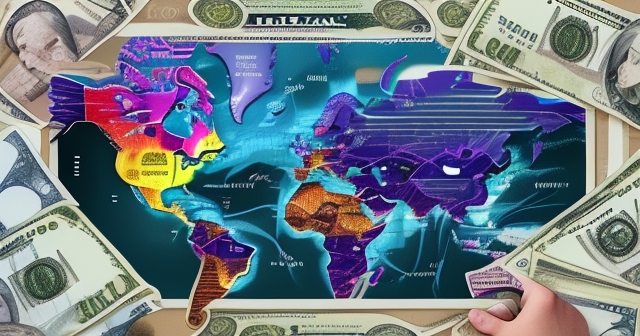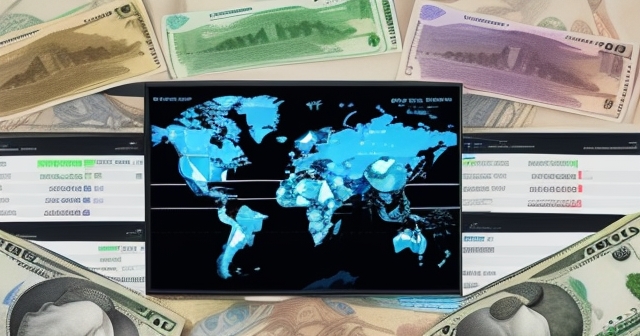Welcome, fellow explorers of the financial markets! You’re embarking on a journey into the fascinating realm of global currencies, specifically focusing on the Group of Seven (G7) nations. These economic powerhouses collectively wield immense influence over international finance, and understanding the forces shaping their currencies is paramount for any serious investor or trader. We are here to guide you through this intricate landscape, breaking down complex concepts and revealing the hidden dynamics that drive value in the world’s most traded currencies.
Think of the G7 currencies – the US dollar (USD), Euro (EUR), Japanese yen (JPY), British pound (GBP), Canadian dollar (CAD), Swiss franc (CHF), and Australian dollar (AUD) – as vital arteries in the global economic body. Their health, stability, and relative strength are constantly influenced by a myriad of factors, from central bank policies and inflation data to geopolitical events and technological innovation. Our goal is to equip you with the knowledge to analyze these influences and make informed decisions.
The key importance of understanding G7 currencies includes:
- They serve as benchmarks for global financial stability.
- Exchange rates reflect economic confidence and investment flows.
- They are influenced by a combination of macroeconomic and geopolitical factors.

The Group of Seven isn’t just a political club; it represents a significant portion of the world’s advanced economies. When their Finance Ministers and Central Bank Governors gather, as they frequently do, their statements and policy directions send ripples across markets. A core tenet they often reaffirm is their commitment to market-determined exchange rates. What does this mean for you as a trader?
Essentially, it signifies a preference for supply and demand dynamics to dictate currency values, rather than direct government intervention aimed at manipulating exchange rates for competitive advantage. However, this commitment isn’t absolute. The G7 communique consistently adds a crucial caveat: they express concern over “excessive volatility and disorderly movements” in exchange rates, noting that such conditions can negatively impact economic and financial stability. This is your signal that while day-to-day fluctuations are accepted, sharp, disruptive swings can potentially trigger policy responses or coordinated statements.
Consider exchange rates like pressure gauges for national economies. They reflect market confidence, capital flows, and relative economic performance. When a currency experiences excessive volatility, it’s often a symptom of underlying stress – perhaps unexpected inflation, political instability, or a sudden shift in global risk sentiment. The G7’s focus on stability provides a framework within which these currencies operate, attempting to mitigate the most extreme fluctuations that could harm international trade and investment.

If market forces are the primary drivers, what exactly are those forces? For G7 currencies, the key elements often revolve around a familiar set of macroeconomic and geopolitical factors. Let’s unpack the recent context, as highlighted in the provided data, focusing on the strength of the US dollar.
Why has the USD been particularly robust lately, often at the expense of currencies like the Japanese yen? The G7 officials themselves pointed to two major culprits: strong U.S. economic growth and receding expectations of Federal Reserve interest rate cuts. Think of a currency like a stock in a country’s economy. When the “company” (the U.S. economy) is performing strongly, exhibiting robust growth figures, investors are more attracted to its assets, including its currency.
Furthermore, central bank interest rate policy acts like the “dividend” or “yield” offered by that currency. Higher interest rates (or the expectation of them remaining high for longer) make holding assets denominated in that currency more attractive, as they offer better returns. When the U.S. Federal Reserve faces persistent inflationary pressures, suggesting rate cuts are less likely or further away than previously thought, the attractiveness of the USD relative to currencies from countries where rate cuts might be anticipated sooner (like potentially in parts of the Eurozone or the UK, depending on the data) increases. This differential in growth and interest rate expectations creates powerful currents in the FX market.
This interplay between economic performance, inflation, and central bank policy is a fundamental concept you must grasp. It’s not just about the current rate; it’s about the *expected path* of rates, which is constantly being re-evaluated by markets based on incoming economic data like inflation reports (such as the Consumer Price Index, or CPI) and employment figures.
To further illustrate the importance of these elements, we can summarize the key forces driving G7 currencies in the following table:
| Forces Driving G7 Currencies | Description |
|---|---|
| Economic Performance | Influences investor sentiment and asset attractiveness. |
| Interest Rates | Higher rates can attract more foreign investment. |
| Geopolitical Stability | Political stability tends to strengthen a currency’s value. |

Beyond traditional macroeconomic forces, the G7 is also actively exploring the future of money itself. One of the most significant initiatives discussed involves Central Bank Digital Currencies (CBDCs), particularly in the wholesale space. You might have heard about CBDCs in the context of potential “digital cash” for consumers, but the G7 is also focusing on the plumbing of the financial system – how banks settle large transactions with each other.
Enter the “Agora project.” This ambitious trial, spearheaded by the Bank for International Settlements (BIS) and involving key G7-linked central banks like the New York Fed, aims to test the practical use of tokenised bank deposits and wholesale CBDCs. Forty major commercial banks, including giants like JPMorgan, HSBC, UBS, and MUFG, have joined this undertaking. What are they trying to achieve?
The primary goal is to revolutionize cross-border payments. Think about how complex and slow international bank transfers can be. They involve multiple intermediary banks, different time zones, varying legal and regulatory requirements, and disparate technical systems. This complexity adds costs, delays, and risks.
The Agora project envisions a system where banks can hold and transfer claims on central bank money (wholesale CBDC) or tokenised versions of commercial bank money instantly and securely on a shared digital platform. This could dramatically speed up settlement times, reduce costs, and increase transparency in wholesale financial markets. It’s like upgrading from sending letters via multiple post offices to sending encrypted emails directly between secure servers.

Let’s delve a bit deeper into the mechanics and implications of the Agora project. The trial is testing multi-currency transactions using these digital tokens. For example, settling a large trade involving Euros and Japanese Yen could potentially happen near-instantly on a platform where both central banks and commercial banks have direct access, rather than going through correspondent banking chains that might take days.
This isn’t just a technical exercise; it has strategic implications. The G7 nations are keen to ensure their financial systems remain at the forefront of innovation in a rapidly evolving digital landscape. Projects like Agora are seen as crucial for maintaining the efficiency and competitiveness of G7 financial hubs, and for potentially setting global standards for the future of wholesale finance.
It’s also important to see this in the context of other global initiatives. The data points out that Agora is distinct from projects like the mBridge project, which involves countries like China and the UAE, also exploring cross-border digital payments. While the underlying technology (like distributed ledger technology) might be similar, the participants, governance structures, and policy objectives can differ significantly. The G7’s involvement in Agora signals their collective effort to innovate within their established frameworks and regulatory principles, potentially positioning their currencies and financial institutions for the digital age.
For you as an investor, understanding the progress of initiatives like Agora is crucial. While not directly impacting retail FX trading today, successful wholesale CBDCs could fundamentally alter the infrastructure of the global financial system, potentially influencing liquidity, settlement risk, and the overall efficiency of capital markets in the future. This is a long-term trend to monitor closely.

The world is not just driven by economics and technology; geopolitics plays a massive role, and G7 currencies are often at the forefront of absorbing these shocks. The G7 officials consistently highlight geopolitical events as significant risks to the global economic outlook. The data specifically mentions the ongoing war against Ukraine and escalating tensions in the Middle East, such as Iran’s attack on Israel, as prime examples.
How do these events translate into currency movements? Geopolitical risks can trigger several effects:
-
Safe-Haven Flows: In times of uncertainty, investors tend to seek refuge in assets perceived as safe. The US dollar, due to its status as the world’s primary reserve currency and the depth/liquidity of U.S. markets, is often a beneficiary of these flows. The Swiss franc and Japanese yen have also historically served safe-haven roles, although their effectiveness can vary depending on the specific nature of the crisis.
-
Supply Chain Disruptions: Conflicts or sanctions can disrupt global supply chains, leading to higher costs for raw materials, energy, and finished goods. This can fuel inflation, impact economic growth, and thus influence central bank policy expectations and currency values.
-
Sanctions and Financial System Impacts: Measures like freezing Russian sovereign assets, discussed by the G7 as a means to assist Ukraine, highlight how geopolitical actions directly impact financial flows and the perceived risk of holding assets in certain jurisdictions or currencies.
-
Confidence Shocks: Elevated geopolitical risk can erode business and consumer confidence, leading to reduced investment and spending, which in turn can slow economic growth and weaken a nation’s currency.
As a trader or investor, you must be acutely aware of the geopolitical landscape. It’s not enough to just read economic data; you need to understand how international events could suddenly shift market sentiment and trigger rapid currency movements, often overriding traditional economic fundamentals in the short term. The G7’s focus on these risks underscores their potential impact on the very stability they aim to maintain.
Recent G7 discussions have also emphasized strategic economic initiatives aimed at building long-term resilience and countering perceived threats to the international economic order. Two key areas are strengthening global supply chains and actively countering economic coercion.
The push for supply chain resilience stems from the lessons learned during the pandemic and subsequent geopolitical disruptions. Over-reliance on single sources or regions for critical goods (like semiconductors, medical supplies, or specific raw materials) proved vulnerable. The G7’s strategy involves encouraging diversification, supporting production in trusted partner countries (including low and middle-income nations), and potentially “friend-shoring” or “near-shoring” vital industries.
How does this affect currencies? Successful diversification can make G7 economies less susceptible to external shocks, potentially contributing to greater economic stability and reducing supply-side inflationary pressures over time. It can also shift trade flows and investment patterns, subtly influencing the demand for different currencies.
Equally significant is the G7’s strong stance against economic coercion. This refers to the use of economic measures (like sudden export restrictions, boycotts, or targeted sanctions) by one country to pressure another for political ends. The G7 sees this as a threat to the rules-based international trading system and has established a Coordination Platform to share information and develop collective counter-measures. While often implicitly aimed at practices seen from countries like China, this initiative signals the G7’s willingness to use coordinated economic statecraft.
This strategic focus is crucial for understanding the long-term environment in which G7 currencies operate. A more resilient economy is inherently more attractive to investors, potentially supporting currency value. Conversely, being the target of economic coercion could create headwinds. These G7 strategies aim to reduce such vulnerabilities and protect their economic interests, which ultimately underpins the value of their currencies.
While the G7 meets and discusses broad policies, the day-to-day management of their economies and, crucially, their monetary policy, lies with their independent central banks: the Federal Reserve (Fed) in the U.S., the European Central Bank (ECB) for the Eurozone members (Germany, Italy, etc.), the Bank of England (BoE) in the UK, the Bank of Japan (BoJ), the Bank of Canada (BoC), the Swiss National Bank (SNB), and the Reserve Bank of Australia (RBA). These central banks often face different economic realities, particularly concerning inflation and growth, leading to divergent monetary policy paths.
The challenges include variances such as:
- Pressure on the Fed from stubborn core inflation.
- ECB possibly contemplating earlier rate cuts due to a different inflationary picture.
- Bank of England’s policies responding to fluctuating wage growth data.
- Bank of Japan managing its unique deflationary context.
These differences in monetary policy expectations are arguably the most powerful short-to-medium term driver of G7 currency movements. A central bank expected to raise rates or keep them high makes its currency more attractive (higher yield). A central bank expected to cut rates or maintain dovish policies makes its currency less attractive (lower yield).
| Factors Affecting G7 Currency Performance | Impact Description |
|---|---|
| Central Bank Policies | Differing approaches lead to varying currency attraction based on rates. |
| Economic Indicators | Data releases shape expectations regarding currency movements. |
| Global Events | Geopolitical and financial crises can rapidly impact currency stability. |
Understanding the nuances of each G7 central bank’s mandate, their current assessment of the economy, and the market’s expectations for their future actions is vital. Are they focused primarily on inflation? Is unemployment a bigger concern? How are they interpreting the latest data releases?
By following central bank communications, dissecting their meeting minutes, and analyzing key economic indicators specific to each nation, you gain insights into the potential trajectory of their interest rates, which directly impacts the relative attractiveness and performance of their respective currencies.
If you’re just starting to explore how these fundamental drivers translate into currency trades, perhaps focusing on major pairs like EUR/USD, GBP/USD, or USD/JPY, understanding the divergent paths of the central banks involved is step one. Their policy decisions and forward guidance often create significant trending opportunities or periods of volatility.
If you’re considering venturing into foreign exchange trading or exploring more Contracts for Difference (CFD) products, then Moneta Markets is a platform worth considering. Based in Australia, it offers over 1000 financial instruments, suitable for both beginners and professional traders.
Let’s briefly shine a spotlight on some of the major G7 currencies and their recent contexts, drawing from the provided data points:
-
US Dollar (USD): As discussed, its strength has been tied to robust U.S. growth and the market repricing Fed rate cut expectations due to persistent inflation. The USD often acts as a global benchmark and safe haven. Its trajectory remains heavily dependent on U.S. economic data and Fed communications.
-
Euro (EUR): The Euro’s performance against the USD has reflected the differing macroeconomic pictures and central bank stances. If the ECB signals or executes rate cuts before the Fed, this typically puts downward pressure on the EUR/USD pair. Internal factors within the Eurozone, though not explicitly detailed for recent periods in the provided data beyond a mention of the ECB stance, also play a role.
-
Japanese Yen (JPY): The yen has significantly weakened against the strong USD. This is partly due to the wide interest rate differential between the U.S. and Japan (where rates have remained very low despite the recent minor adjustment by the BoJ) and perhaps less robust growth prospects compared to the U.S. While the yen can act as a safe haven, the yield disadvantage can sometimes outweigh this during periods of broad USD strength.
-
British Pound (GBP): The GBP faces its own set of dynamics, influenced by the Bank of England’s policy response to UK inflation and growth data. Geopolitical factors, such as the lingering complexities of the Brexit-related Northern Ireland Protocol, can also pose potential, albeit sometimes muted, risks or uncertainties for the pound relative to the Euro and other currencies.

Understanding the specific economic and political context of each G7 nation is essential. While they meet as a group, their individual currencies dance to the tune of their domestic conditions and the unique policy challenges their central banks face.
The multifaceted actions and discussions among G7 nations paint a picture of a group grappling with a rapidly evolving global landscape. They are simultaneously:
-
Managing immediate macroeconomic pressures like inflation and growth.
-
Responding to acute geopolitical risks that threaten stability.
-
Investing in the future infrastructure of finance through digital currency exploration.
-
Strategically positioning their economies to be more resilient against future shocks and coercion.
These initiatives are not happening in a vacuum. They are responses to the rise of new economic powers, technological shifts, and increased global interconnectedness. The long-term value and stability of G7 currencies will depend on the success of these efforts. Can they maintain the dominance of their financial systems in a digital age? Can they successfully diversify supply chains and counter economic coercion without fragmenting global trade? Can their central banks navigate inflationary pressures while supporting sustainable growth?
These are the big questions that will shape the future performance of the USD, EUR, JPY, GBP, and their counterparts. As informed investors, keeping an eye on the G7’s collective actions, statements, and the outcomes of their initiatives is as important as tracking individual economic data releases.
Equipped with this understanding of the G7’s influence, how should you approach trading or investing in their currencies? Here are a few guiding principles:
-
Fundamental Analysis is Key: While technical analysis helps time entries and exits, the primary drivers of G7 currencies over the medium to long term are fundamentals – central bank policy, inflation, growth, and geopolitical stability. Pay close attention to economic calendars, central bank meeting announcements, and major geopolitical developments.
-
Understand Divergence: Focus on the *relative* strength or weakness between two economies and their central banks. Trading EUR/USD, for example, is less about the absolute state of the U.S. or Eurozone economy and more about which one is performing better or whose central bank is expected to tighten/loosen policy more aggressively.
-
Monitor G7 Communiques: While often high-level, their statements on exchange rates and global risks can provide clues about collective concerns and potential future policy coordination, or at least signal the issues market participants should be focusing on.
-
Be Aware of Geopolitical Risk: Have a plan for how you will react to unexpected geopolitical events. Safe haven flows can be swift and significant.
-
Consider the Long-Term Strategic Picture: Initiatives like CBDC development or supply chain restructuring signal long-term trends that could eventually impact the attractiveness and stability of G7 financial markets and their currencies. While not for day trading, these inform your long-term investment perspective.
Trading the G7 currencies means trading the pulse of the global economy. It requires a blend of macroeconomic understanding, geopolitical awareness, and central bank policy analysis. It’s challenging, but incredibly rewarding for those who take the time to understand the forces at play.
When choosing a trading platform, Moneta Markets‘ flexibility and technological advantages are worth noting. It supports popular platforms like MT4, MT5, and Pro Trader, combining high-speed execution with low spread settings to provide a good trading experience.
If you are looking for a regulated forex broker that enables global trading, Moneta Markets holds multiple international regulatory licenses, including FSCA, ASIC, and FSA. It also offers segregated client funds, free VPS, and 24/7 Chinese customer support, making it a preferred choice for many traders.
Conclusion: Embracing the Complexity for Informed Decisions
The world of G7 currencies is a dynamic confluence of economic data, central bank intentions, geopolitical realities, and technological innovation. The G7 nations, through their coordinated discussions and individual actions, play a pivotal role in shaping the environment in which these major currencies operate.
From reaffirming commitment to stable exchange rates while acknowledging volatility concerns, to pioneering the future of finance with wholesale CBDCs in the Agora project, and strategically building resilience against geopolitical and economic threats – the G7’s focus areas are critical determinants of currency performance.
As an investor or trader, your ability to synthesize these different layers of influence – from micro-level economic data to macro-level G7 strategy – will define your success. By understanding the “why” behind currency movements, paying attention to the stated goals and concerns of G7 leaders, and recognizing the impact of global events, you can navigate these complex markets with greater confidence and precision.
Remember, knowledge is your most powerful asset in the financial markets. Continue learning, continue analyzing, and approach the G7 currencies with a deep understanding of the powerful forces that guide their path.
g7 currenciesFAQ
Q:What are the primary currencies involved in the G7?
A:The primary G7 currencies include the US dollar (USD), Euro (EUR), Japanese yen (JPY), British pound (GBP), Canadian dollar (CAD), Swiss franc (CHF), and Australian dollar (AUD).
Q:How do geopolitical events affect G7 currencies?
A:Geopolitical events can create safe-haven flows, disrupt supply chains, and affect investor confidence, leading to fluctuations in currency values.
Q:What role do central banks play in G7 currency movements?
A:Central banks influence currency movements through their monetary policies, interest rates, and responses to economic conditions, which can attract or deter investment.
